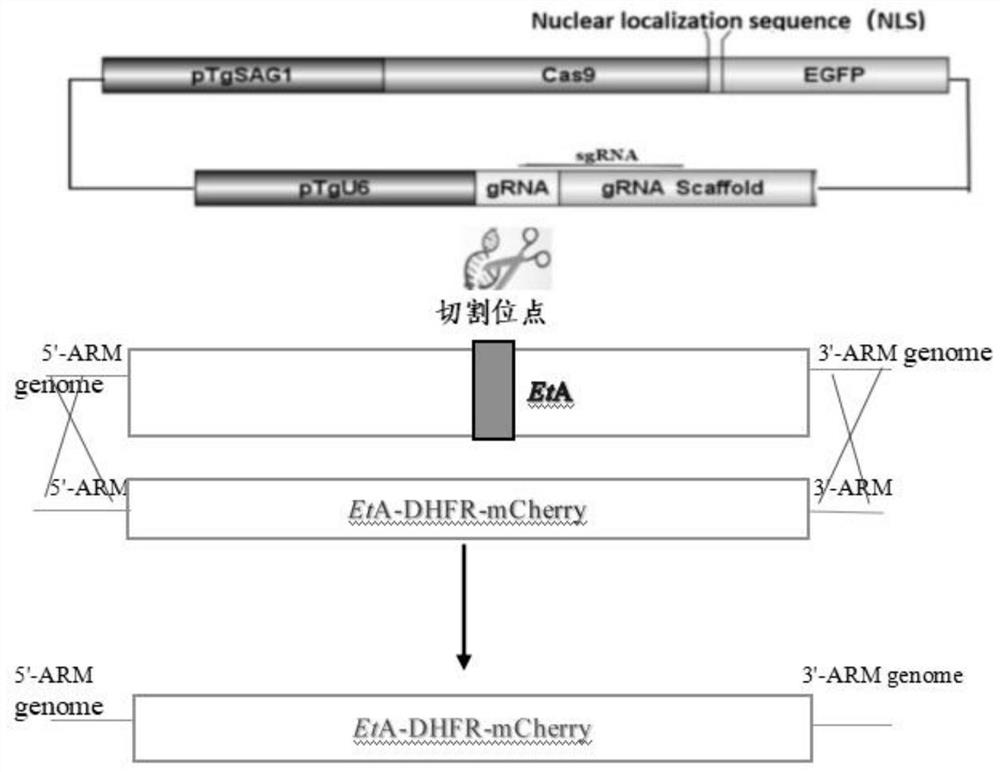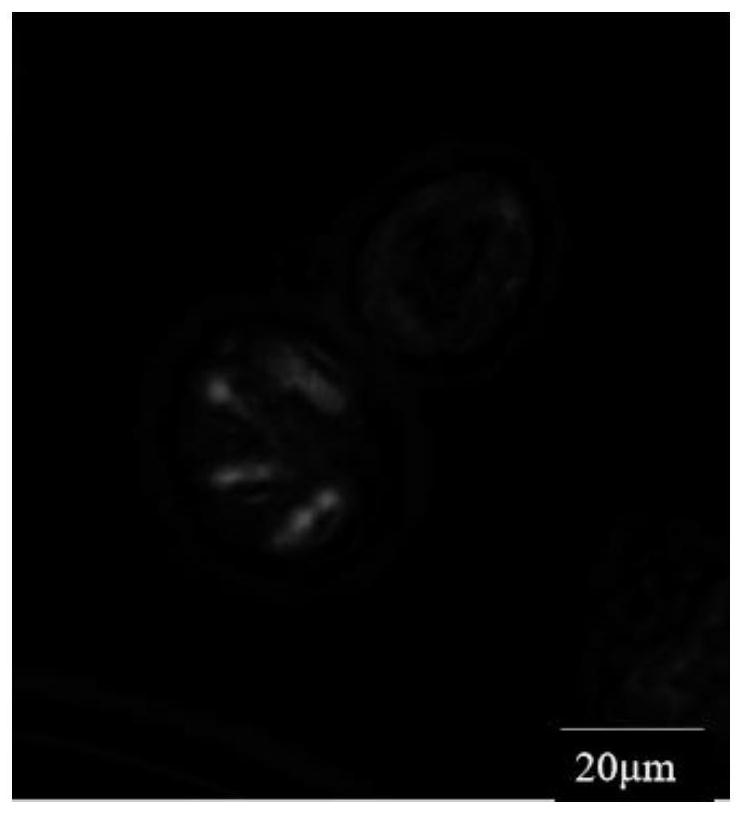Construction method for coccidia expressing exogenous fluorescent protein
A construction method and protein coccidia technology, applied in the field of genetic engineering, can solve the problems of limited expression of fluorescent reporter genes, poor fluorescent signal, and poor fluorescent labeling effect, etc.
- Summary
- Abstract
- Description
- Claims
- Application Information
AI Technical Summary
Problems solved by technology
Method used
Image
Examples
Embodiment 1
[0055] Construction method of gene editing plasmid pCRISPR::EtA plasmid containing gRNA
[0056] 1. According to the Eimeria tenella (E.tenella) gene sequence (ETH_00017055) information, design gRNA, construct sgRNA vector, and the designed primer is CRISPR-EtA-F (containing EtA target-specific gRNA sequence) (SEQ ID NO: 2) and CRISPR-R (GOI-gRNA-Rv) (SEQ ID NO: 3).
[0057] 2. Using CRISPR-EtA-F and CRISPR-R as primers, pSAG1::Cas9-U6::sgUPRT plasmid as a template, use the Q5 point mutation kit to perform PCR reaction, then perform KLD reaction on the PCR product, and then KLD mixture Transform Stbl3 competent cells, and then identify positive clones to obtain pCRISPR::EtA plasmid.
[0058] The sequencing result of the pCRISPR::EtA plasmid is shown in SEQ ID NO: 4, and the sequencing result shows that the gRNA has been integrated into the plasmid. The results of sequencing indicated that a suitable pCRISPR::EtA plasmid was obtained.
Embodiment 2
[0060] Construction method of homologous recombination plasmid
[0061] 1. Amplify the gene fragment of the downstream 5'-homology arm of the EtA gene
[0062] Primers EtA 5'-ARM-F (SEQ ID NO: 5, containing the HindIII restriction site) and EtA 5'-ARM-R (SEQ ID NO: 6) were designed to target the genome DNA of Eimeria tenella Guangdong strain As a template, the 5'-ARM sequence of the EtA gene was amplified as the downstream homology arm sequence. After the PCR product was sequenced, the nucleotide sequence of the downstream EtA 5'-ARM was obtained as shown in SEQ ID NO:1.
[0063] 2. Amplification of screening genes and fluorescent genes
[0064] Construction of EtA-DHFR-mCherry-3UTRDHFR Sequence Fragment Containing Upstream EtA 5' Homology Arm
[0065] (1) Amplify the upstream regulatory sequence of DHFR and the open reading frame sequence of DHFR: design primers DHFR-5'-F (SEQ ID NO: 7) and DHFR-R (SEQ ID NO: 8), and use them as upstream and downstream primers , with the ...
Embodiment 3
[0074] The gene fragment of the downstream 5'-homology arm obtained in Example 2, the EtA-DHFR-mCherry-3'UTRDHFR homology arm sequence containing the upstream EtA 5' homology arm sequence and the gene fragment of the downstream 3'-homology arm Ligation is performed to obtain a long fragment containing 5'-homology arm-DHFR-mCherry-3'UTRDHFR homology arm sequence-3'-homology arm and the pcDNA 3.1(+) vector after digestion with BamHI and Hind III The sequences were ligated sequentially through the ClonExpress MultiS One Step Cloning Kit to obtain the successful targeting DHFR resistance plasmid pEtA::DHFR-mCherry (SEQ ID NO: 25).
[0075] Use CRISPR / Cas9-mediated integration at specific sites to insert resistance screening elements and fluorescent genes, use the upstream homology arm of the EtA gene to connect the resistance screening element and the fluorescent gene to be knocked in, and the downstream homology arm of the EtA gene. Construct recombinant plasmids as targeting pla...
PUM
 Login to View More
Login to View More Abstract
Description
Claims
Application Information
 Login to View More
Login to View More - R&D
- Intellectual Property
- Life Sciences
- Materials
- Tech Scout
- Unparalleled Data Quality
- Higher Quality Content
- 60% Fewer Hallucinations
Browse by: Latest US Patents, China's latest patents, Technical Efficacy Thesaurus, Application Domain, Technology Topic, Popular Technical Reports.
© 2025 PatSnap. All rights reserved.Legal|Privacy policy|Modern Slavery Act Transparency Statement|Sitemap|About US| Contact US: help@patsnap.com


